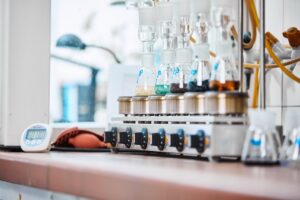
Alkylphenols and alkylphenol ethoxylates
DIN EN ISO 18254-1 specifies a method for determining the content of Alkylphenol ethoxylates (APEOs) in textiles. DIN EN ISO 21084, on the other hand, describes a method for determining Alkylphenols (APs) concentration in textiles. Both methods involve extraction in an ultrasonic bath and subsequent measurement by HPLC-DAD or GC-MS.
